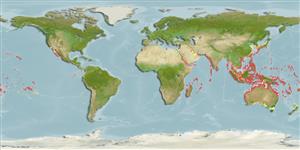Common names from other countries
Classification / Names / Names
Populärnamn | synonymer | Catalog of Fishes (gen., sp.) | ITIS | CoL | WoRMS
Environment: milieu / climate zone / depth range / distribution range
Ekologi
; djupintervall 10 - 30 m (Ref. 337). Tropical
Indo-Pacific.
Length at first maturity / Size / Vikt / Age
Maturity: Lm ? range ? - ? cm Max length : 8.0 cm SHL hane/ej könsbestämd; (Ref. 349); common length : 6.5 cm SHL hane/ej könsbestämd; (Ref. 349)
Collected by coastal populations in the tropical West Pacific for food and shell trade (Ref. 349). Often very common (Ref. 349). Found at depths of 10 to 30 m, on alga-covered rock (Ref. 337), and on coral reef flats on coral atolls and in tide pools on thin alga-sand bottom (Ref. 87884).
Life cycle and mating behavior
Könsmognad | Reproduktion | Lek | Ägg | Fecundity | Larver
Members of the order Neotaenioglossa are mostly gonochoric and broadcast spawners. Life cycle: Embryos develop into planktonic trocophore larvae and later into juvenile veligers before becoming fully grown adults.
Poutiers, J.M. 1998. (Ref. 349)
IUCN Red List Status (Ref. 130435)
CITES status (Ref. 108899)
Not Evaluated
Not Evaluated
Threat to humans
Harmless
Human uses
Fiskeri: kommersiell
| FishSource |
Verktyg
Ytterligare information
Age/SizeTillväxtLength-weightLength-lengthMorfologiLarverAbundans
Internet-källor
Estimates based on models
Preferred temperature
(Ref.
115969): 23.8 - 29, mean 27.8 (based on 432 cells).
Vulnerability
Low vulnerability (10 of 100).
Price category
Unknown.
